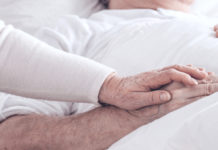First Aid Kits
A first aid kit can be handy, and even lifesaving, in times of need. Be prepared for emergencies by purchasing a first aid kit or putting one together with the following items:
- List of emergency contacts, including family members, doctor, pharmacist, and poison control
- List of insurance information and current medications
- Bandages in assorted sizes
- Gauze and tape
- Hand sanitizer, antiseptic wipes, and soap
- Antibiotic ointment
- Aspirin or other pain reliever
- Non-latex gloves and a plastic bag for disposal
- A non-mercury and non-glass oral thermometer
- Tweezers and scissors
- A blanket
- Cold pack and compress
- Blood pressure cuff and glucose meter, along with insulin as needed
- Automated external defibrillator (AED) machine
- First aid instruction booklet
As a quality assurance tip, the first aid kit should be checked regularly to confirm the necessary components are available and not expired or out-of-date.
Falls
Falls are the leading cause of home injury death, with one out of every three seniors aged 65 and older falling each year. To limit the risk of falls, ensure home safety for the elderly by offering adequate lighting, installing railings in the stairways and bathrooms, and eliminating clutter. But even with precautionary measures taken and in place, falls can still arise. Along with safely picking up a senior after a fall, medical attention should be notified as soon as possible. The doctor will assess for all potential injuries, any underlying health condition that may have caused the fall, abnormal labs tests, and gait and balance concerns.
Cuts
Whether caused from a fall or by an accident in the kitchen, a cut or abrasion needs responsive attention to lower the risk of infection and additional damage to the vessels, nerves, and muscle tissues. Proper cut and wound handling include the following steps:
- Apply pressure and control the bleeding.
- Use running water and soap to cleanse the area of the wound, along with removing any dirt, glass or debris that may be in it.
- Dress the wound temporarily until receiving medical attention if needed.
- If medical attention is needed, follow the directional care provided, including antibiotics that may be prescribed.
Burns
Especially among seniors who smoke or still cook in the kitchen, burns can be a common problem. Managing a burn can be as simple as allowing it to heal naturally or requiring intensive rehabilitation. After extinguishing or evacuating the fire source, treat mild first or second-degree burn with the following steps:
- Remove any jewelry or clothing at the site of the burn. If clothing is stuck to the burn, do not remove it and carefully cut around the stuck fabric to remove loose fabric.
- Cover the burn with a clean, dry cloth to reduce the risk of infection.
- Use cool cloths on the burn, not ice or butter.
- To relieve pain and swelling, apply a soothing, aloe vera-containing lotion or hydrocortisone cream to the burned area(s).
If the burn is third degree and severe, call for emergency medical assistance immediately.
Choking Incidences
Choking is a leading cause of death in seniors aged 76 or older and commonly caused by swallowing difficulties, consuming foods not texturally modified to accommodate special diet needs, and eating too quickly. If you see a senior choking, first ask whether or not the sufferer is in fact choking and if they can speak. Do NOT intervene if the person is coughing and able to verbalize, as a forceful cough can help dislodge the object. But if the person is choking and needs assistance, jump in with these first aid tips, including the Heimlich maneuver. If repeated attempts do not free the airway, call 911. While cardiopulmonary resuscitation (CPR) is the next step if someone loses cautiousness, it may not always be the best decision for the elderly population. Healthcare experts encourages everyone, especially older adults with advanced chronic illnesses, to talk to their loved ones about their wishes regarding resuscitation.
Heart Attacks
With the average age of a first heart attack being 64.7 years for men and 72.2 years for women, it is important for caregivers to recognize the common signs of one. Initial signs of a heart attack are sudden chest pain lasting for more than a few minutes and shortness or breath before the discomfort begins. The pain usually starts at the center of the left side of the chest, potentially coming and going away in spurts. The senior may describe the pain as “squeezing” or “fullness,” along with reporting feelings of heartburn and indigestion. Additional signs of a heart attack include tingling in the arms, pain in the upper part of the body, nausea, vomiting, dizziness, and sudden sweating. If you suspect your loved one is experiencing a heart attack, call for 911 without hesitation and immediately.
Strokes
Stroke is also common among the elderly, especially seniors become older in age. According to the American Stroke Association (ASA), you should use the acronym “fast” to spot stroke signs:
- Face drooping: Does one side of the face droop or is it numb? Ask the person to smile. Is the person’s smile uneven or lopsided?
- Arm weakness: Is one arm weak or numb? Ask the person to raise both arms. Does one arm drift downward?
- Speech difficulty: Is speech slurred? Is the person unable to speak or hard to understand? Ask the person to repeat a simple sentence. Is the person able to correctly repeat the words?
- Time to call 911: If someone shows any of these symptoms, even if the symptoms go away, call 9-1-1 and say, “I think this is a stroke” to help get the senior to the hospital as soon as possible. Also note the time when the first symptoms appeared, emergency responders will want to know for a thorough assessment.
Unsure? Call 911 anyways!






